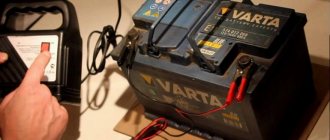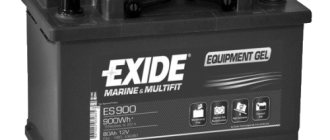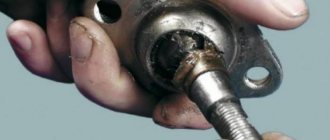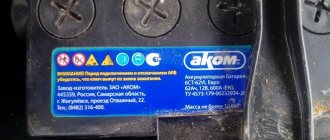Almost always, problems with car batteries begin with the onset of cold weather. All chemical reactions slow down at low temperatures.
You just need to distinguish between the natural discharge of the battery due to improper operation or partial loss of capacity and final failure, when further attempts to preserve it are fraught with big problems with starting the engine.
Sluggish and dim
You can guess that the battery is bad when starting the car. If the indicators on the panel or the interior lighting noticeably dim, and the starter barely turns the crankshaft, then the battery is clearly not itself. Of course, oxidized terminals and, say, a simple undercharging of the battery due to a negative energy balance may be to blame, but in any case, this is a reason to find out the reason for such “sluggishness.” And if the terminals are well tightened, and the travel mode allows the battery to be recharged on the road, then it may very well be that the battery is simply time to retire.
Symptoms of a dead battery
What are the signs of a low car battery? There are many of them, but not all of them can clearly indicate that the battery is low. Many symptoms of supposed discharge are often caused by a malfunction of other components.
Electrolyte density
If the battery is serviceable, and we really service it - we monitor the electrolyte level and its normal density, then you can check the condition of the battery with a hydrometer. We unscrew the plugs and measure the density of the electrolyte in each jar.
Measuring electrolyte density using a hydrometer
We check the plate below and determine the battery charge level, taking into account the climatic regions in which the car is operated.
Dependence of electrolyte density on the state of charge of the car battery
| Climatic zone (average temperature in January, °C) | Density of a fully charged battery at 15 °C, g/cm3 | Density, g/cm3 at vacuum level, % | |
| 25 | 50 | ||
| Very cold (-50 … -30) | 1,29 | 1,25 | 1,21 |
| Cold (-30 … -15) | 1,28 | 1,24 | 1,20 |
| Moderate (-15 … -4) | 1,26 | 1,22 | 1,18 |
| Warm (-15 … +4) | 1,24 | 1,20 | 1,16 |
| Hot (+4 … +6) | 1,22 | 1,18 | 1,14 |
Important! If the density variation in the banks is 4 hundredths or more, then this is a clear sign of battery wear. It's time to think about buying a new battery. In addition, if an electrolyte of unknown density was first poured into the battery, then it will not be possible to assess the state of charge in this way.
Voltage
How can you tell if your battery is low if it has a maintenance-free design or if you don’t have a hydrometer on hand? It will be realistic to check the battery charge level by the voltage at its terminals. We take a tester (multimeter), set the DC voltage measurement mode to 20–30 V, measure the voltage at the battery terminals and check our table.
Dependence of voltage at the terminals on the state of charge of the car battery
| Terminal voltage without load, V | Charge level, % | |
| low antimony (Sb/Sb) and hybrid (Sb/Ca) | calcium (Ca/Ca) and AGM/Gel (Ca/Ca) | |
| 12,51–12,66 | 12,66–12,81 | 100 |
| 12,31–12,46 | 12,46–12,61 | 75 |
| 12,10–12,25 | 12,26–12,41 | 50 |
| 11,92–12,07 | 11,86–12,01 | 25 |
| 11,75–11,90 | 11,66–11,81 | 0 |
Important! To get an accurate result, it is necessary to measure the voltage on the battery, which has stood without load (energy consumers for at least 2 hours).
Starter operation
You can understand that the car’s battery is discharged by the behavior of the starter. Since a dead battery is not able to produce the current necessary for its operation, starting is difficult, the starter turns as if with effort. If the battery is severely discharged, the starter may not turn over at all if it tries to do so. At the same time, the dashboard lighting dims significantly. In a very severe case, instead of the “grunting” of the starter, you can only hear faint clicks of the retractor relay.
Do not forget that this sign is indirect. Starting problems can also be caused by other reasons:
- very thick oil in the crankcase (starting a very frozen car);
- malfunction of the starter and retractor relay;
- loss of contact between the battery terminals and tips due to oxidation.
Operation of other electrical equipment
That the battery is discharged can be determined by the operation of electrical appliances.
- the headlights and the interior lamp shine dimly;
- locking and unlocking of doors occurs as if reluctantly - the buttons are lazily pulled out;
- the security system responds slowly to commands from the remote control and false alarms occur;
- When the power windows are activated, the windows go up and down noticeably slower;
- The car radio spontaneously changes operating modes and can turn on or off on its own.
Expert opinion
Alexey Bartosh
Specialist in repair and maintenance of electrical equipment and industrial electronics.
Ask a Question
Important! All these signs will also be indirect, and it is possible to conclude that the battery is discharged only when they appear in combination, even if not all of them listed above. After all, window lifts may not work well due to a faulty electric drive, and the radio will be “strange” if it simply breaks down.
Acting
A fairly common situation in the modern automotive world: on cars with a “start-stop” mode, instead of an expensive AGM battery, a regular “plebek” is installed. The reason, as a rule, is one: poverty, less often - the greed of the owner. If he turns off the start-stop mode every time, then the battery will, of course, last for some time, but in real situations no one usually does this. And since a simple battery is not designed for deep discharges, it can die much earlier than its intended date. Therefore, at the first signs of the “blues”, the owner must understand: most likely he has already ruined the poor battery...
We invite everyone who wants to share their methods of assessing the residual battery life to do so!
- You will find inexpensive Russian battery chargers in the assortment of our online store.
Why might your battery drain?
Let's start with the reasons that can cause a serious battery discharge. The most common one is that I forgot to turn off the headlights (DRLs, side lights, interior lights). In the morning I came to the parking lot or garage - the battery was completely discharged.
This kind of forgetfulness can cost your battery
Another reason is carelessness. We went on a picnic, listened to music for half a day, when it got dark, we illuminated the impromptu dance floor with headlights. We were getting ready to leave - it was impossible to start the engine, and the nearest help was three days away through the forest.
If the fun drags on, one of the cars may not start without outside help.
And now for more serious problems:
- Malfunction of charging circuits. If the voltage supplied to the on-board network is too low, then the battery either does not charge well during the trip, or (even worse) even discharges, providing the car with electricity instead of the generator.
- Short trips with frequent starts. Theoretically, the energy spent by the battery to start the engine is replenished from the generator while driving. But if the trips are short, then there is not enough time to charge, and the battery is discharged more and more after each successive engine start.
- High battery self-discharge. Any battery is discharged without even supplying power to the car's consumers. The longer the battery lasts, the higher its self-discharge. A badly worn battery can discharge on its own even overnight.
- High leakage current. When parked, any new car consumes some amount of energy from the battery. Alarm system, on-board computer circuits, “sleeping” radio - all this requires power. If any of these components is faulty or the wiring is damaged, then due to the large leakage current the battery will be discharged even after a short stay.
With such a leakage current, the battery will quickly discharge
What to do if the car battery is dead
Many drivers are faced with the question “what to do if the car battery is dead?” There are several ways to start a car with a dead battery. Depending on the circumstances (reason for discharge, location, availability of tools and the ability to ask for help from other drivers), you can choose the option that is suitable for you.
Use a jump charger
This is the easiest way. Using a jump charger, you can either simply charge the battery or start a car with a discharged battery. To do this, you need to connect this mechanism to the network and set 15–20 A. Connect the positive wire to the positive terminal of the battery, and the negative wire in the area of the starter to the unit. After that, start the car and disconnect the device.
"Light a cigarette"
If you don’t have a special device at hand, you can use the help of other drivers by asking them to “light a cigarette.” To do this, you will need high-voltage wires with fastenings for alligator clips. What do we have to do:
- First of all, we are looking for a car with a charged battery. Moreover, if you have a 12 V battery, then the donor must also have a 12 V battery. The same applies to 24 V - they need a 24 V battery. Also, it is better to start a diesel unit from a diesel engine, and a gasoline unit from a gasoline one.
- The donor car must be driven as close to yours as possible to run the wires. After which both cars should be turned off.
- We connect two batteries with wires: plus to plus, minus to minus. In this case, we first connect the positive (red) wire, and then the negative (black), in sequence - from the donor to the discharged battery.
- We start the donor car, let it run for a few minutes, after which you can start your car. You should let both machines run for 10 minutes to give your battery time to recharge.
- We remove the jumper wires, after which it is recommended to let your car run for 20–30 minutes so that the battery is better recharged.
There is another way to “light it” if you don’t have any wires. To do this, you need to remove your battery and replace it with the battery from the donor car. Then we start the car and wait for its speed to reach the normal rate. Next, without turning off the engine, we remove someone else’s battery and install our own in its place. For such an operation you will need a standard set of wrenches, just remember that the batteries must be the same.
Start "from the pusher"
Your battery is completely discharged - what to do if there is neither a charger nor wires nearby? In this case, we apply the “pusher” method.
You will need either a second car or a couple of buddies willing to push the car. Let's consider the first method. The second car fits its rear bumper to your front bumper. Both cars are connected by a cable. After this, you need to get behind the wheel, depress the clutch pedal, engage second gear and indicate readiness (blink the headlights or sound the horn). When the car starts moving, smoothly release the clutch pedal and press the gas. The car will start soon.
Keep an eye on the distance between cars and remember that the brakes often do not work well when the car is turned off.
The second method is almost identical to the first, but instead of another car, your comrades are the driving force. You need to take into account their physical capabilities and give them time to accelerate the car a little.
Spin the drive wheel
What to do if the battery is dead, and there are no high-voltage wires or a starting device in the car, and there is not a single car ready to tow you? A jack and a towing cable (rope, etc.) can help here. Using these simple devices, we spin the drive wheel (the principle of operation is the same as that of a manual starter). We proceed as follows:
- We lift the car with a jack, freeing the drive wheel.
- We engage fourth gear.
- We wrap a cable or rope, at least 5 meters long, around the wheel counterclockwise.
- We begin to sharply pull on the end of the rope, spinning the wheel.
This method is acceptable for cars with an engine capacity not exceeding 1.5. In addition, it can only be used in warm weather.
Step-by-step search for current leaks
Step 1
First, fully charge the battery. Make sure the radio and lights are turned off. Also remove the charging plugs for your mobile phone, tablet, laptop and GPS navigator from the cigarette lighter. Be sure to remove the key from the ignition and close all doors. After this, you can use the jumpers you need for clamping. This way you will be able to save all the data, including the anti-theft code itself, in the memory of the on-board computer.
Step 2
Now you can install the ammeter device. Its meter will continuously record current leakage from the battery. If the reading on the ammeter is above 600 milliamps per hour, then this is clearly too much. To do this, you will need to disable parasitic devices.
Step 3
Check if there is a light in the glove compartment. If you find it, it is better to turn it off. It also wouldn’t hurt to check the luggage compartment - maybe the light is on there too. In other words, friends, check absolutely all light sources.
Step 4
When you have eliminated all possible causes by trial and error, the only thing left is to use a test cable that connects to the fuse box, which will help you disconnect all unnecessary loads on the circuit and determine the main device that consumes the most current in the car.
How do you know when your battery is close to being completely discharged?
From the previous parameters, you understood why the car battery drains quickly. It remains to say a few words about how to understand that a complete discharge of the battery is approaching.
In most cases, battery discharge occurs unexpectedly and is very unpleasant. But you can feel it coming by the slow cranking of the crankshaft. A charged battery supplies normal current to the generator, but a discharged battery does not have enough charge for this.
As a result, the starter turns the shaft more slowly than usual. Even if you managed to start the engine the day before with this problem, the next day the battery will completely run out. Therefore, when you arrive from work, immediately put it on charge. Otherwise, in the morning you will be looking for how to start the car if the battery is dead.
You can also play ahead of this situation before the cold weather.
If you have been using the battery for 3-4 years and everything is fine in the summer, then with the onset of cold weather there will definitely be problems. To prevent this from happening, watch the forecast and recharge the battery from the mains charger before the arrival of negative temperatures. Additionally, you can read the article about whether it is possible to charge the battery in a car without removing the terminals.
The most unpleasant consequences of a severely discharged battery
There are dozens of situations that occur when the battery is discharged. For example, the inability to start the engine, especially in the cold season. You can also remember the glitch of the on-board computer, which persistently produces errors and does not allow the engine to start or even does not allow the owner to enter the car. A common problem is also sticking starter contacts. This happens according to this scheme when the battery is discharged:
Of course, this situation is not common; it can only happen on cars that are not equipped with the highest quality electrical network devices. But the problem is that any car older than 5 years is not insured against such troubles. This is one type of trouble, but there can actually be a lot of such problems. It is worth insuring against them and promptly checking and changing the battery if it is too discharged.
How to prevent discharge
To prevent the battery from presenting unpleasant surprises, it is, of course, necessary to monitor it. Here is a small list of simple activities that are worth doing:
- We periodically clean the battery itself from dirt, and its terminals from oxidation.
- At least once every 2-3 months we measure the voltage, if the on-board computer does not do this, once or twice a season we check the density of the electrolyte and its level (for serviced batteries).
- If necessary, we charge the battery with a stationary charger; under no circumstances leave the battery in a discharged state below 40% for a long time, especially in severe frost.
- During long-term parking (for example, in traffic jams), we turn off not particularly important consumers - a stereo system, air conditioning, etc.
- If there is a suspicion that the battery has begun to drain quickly, we measure the leakage current, which during parking should not exceed 50–80 mA. This is easy to do with a regular multimeter: the whole operation will take five minutes, but will help avoid serious problems and destruction of the battery.
- Before leaving the car, we check that all electrical appliances are turned off. Of course, most of the newest cars will warn the driver about the lights being turned on or the doors being open, but, firstly, not all cars can do this and not all equipment is controlled. Secondly, the same DRLs installed independently may not be seen by the on-board computer.
Well, of course, we replace the dying battery with a new one in a timely manner, without waiting until the old battery “dies” completely and gives out a surprise in the morning.
What can cause the battery to discharge quickly?
Below we list the main reasons for a drop in battery voltage:
- Long-term (more than 3 weeks) simple car with connected terminals. Even if everything is fine, the battery will be discharged;
- The battery is old. Naturally, it will have increased self-discharge or even short circuit the plates;
- Increased current leakage (quiescent current);
- Faulty generator, critical brush wear;
- A jammed starter during startup creates a very large load on the battery and can bring it to zero in a few attempts;
- Frequent launches and trips over short distances (up to 10 km);
- Additional energy consumers have been installed (radar detector, navigator, camera, SKNO, meter, etc.);
- Human factor. They just didn’t turn something off or didn’t remove the socket from the cigarette lighter.
In any case, before searching for the cause, you first need to check the condition of the battery at a specialized center.
Why do you need to periodically discharge your car battery?
To understand the meaning of battery discharge, let's remember how it works.
When we turn the key in the ignition, we start a process consisting of the interaction of two battery reagents - lead plates and electrolyte. Closing the electrical circuit initiates the release of electrical energy released during the process of reducing the density of the electrolyte. This process is accompanied by the conversion of some of the lead on the plates into lead sulfate. The reverse process, that is, charging the battery, converts most of the sulfated lead back into pure metal.
As you already noticed, we mentioned the term “most”. This means that some amount of insoluble sulfate remains as such, and this process is commonly called plate sulfation. As the proportion of insoluble residue on the plates increases, the battery capacity begins to decrease. This, so to speak, is the aging of the battery, that is, a completely natural process. The analogy is not direct, but it is successful - the life of the battery, it turns out, can also be extended.
The “correct” lifestyle involves training the battery through cycles of discharging and subsequent charging, during which the battery remembers how to convert lead salts into lead with minimal losses. Such demonstration training must be organized at least once a year, on the eve of the onset of the cold season, and even better, repeat the procedure in the spring.
The event also allows you to assess with great accuracy the condition of the car battery and the degree to which its service life is depleted. You just need to discharge and charge while controlling the time and charge level.
Results
Sometimes it's better to replace a bad battery with a new one rather than try to restore it and run constant risks. A battery that discharges quickly is likely damaged, so you should get rid of it and buy a more powerful one for use. offers to implement battery replacement on the most favorable terms. At our collection points you can donate your car battery at an expensive price and receive a real reward for it. Please check with the manager for current prices and terms of purchase.
Source
Let's sum it up
Unpleasant situations related to the battery during vehicle operation occur virtually all the time. We are talking about troubles with low charge, constant battery discharge, and low quality of accessories sold on the market. There are various options and improvements you can make to your car to improve battery control. But all this does not guarantee the absence of problems. If your alternator belt breaks in the middle of the highway, you will have to put up with the dead battery.
If you don’t want to experience difficulties, you should always properly maintain your car and get maximum reliability in the operation of technical equipment. Change the alternator belt in a timely manner, and always pay attention to the operation of electrical appliances. If you have doubts about the quality of the electrician's work, use the services of a service station and check the operation of the entire circuit. This way you will be able to prevent problems with the battery and the need to buy a new, rather expensive battery. How do you think you can protect yourself from problems with your car battery?
Source











